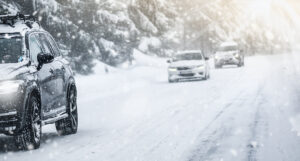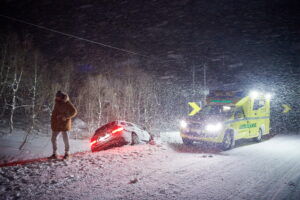
Between black ice, low visibility, and snowy roads, wintertime can cause treacherous driving conditions. If you’re involved in a winter car accident, you have support on your side. Swor & Gatto, Attorneys at Law, will guide you through the legal process and help you recover from your injuries.
As experienced Minneapolis car accident lawyers, we’ll work closely with you to investigate the accident, determine who is at fault, negotiate with the insurance companies on your behalf, and fight for your rights in court if necessary.
Common Winter Car Accidents Injuries
Whatever the season, motorized vehicle accidents can too often result in significant injuries to the drivers and passengers involved. Car, truck, and bus accidents can cause injuries such as:
- Whiplash: This is a soft tissue injury that occurs when the head and neck jerk forward and backward, causing strain on the muscles and ligaments in the neck. Whiplash is a common injury in rear-end collisions, causing symptoms such as neck pain, headaches, and stiffness.
- Broken Bones or Fractures: Car accidents can cause broken bones in the arms, legs, ribs, and other body parts. These injuries can be painful and require extensive medical treatment, including surgery and rehabilitation.
- Spinal Cord Injuries: Spinal cord injuries can occur in car accidents involving high speed or significant impact. These injuries can cause partial or complete paralysis and significantly impact a person’s quality of life.
- Traumatic Brain Injuries: Traumatic brain injuries occur when the brain is jolted or shaken inside the skull, causing damage to brain tissue and resulting in long-term cognitive and physical impairment.
- Soft Tissue Injuries: Soft tissue injuries, such as sprains and strains, can occur when the body experiences sudden impact, such as in a car accident. These painful injuries can limit a person’s range of motion.
- Emotional Distress or PTSD: Car accidents can be emotionally taxing and even lead to post-traumatic stress disorder.
What to Do After an Auto Accident
If a vehicle crash occurs, take the following steps as soon as you can:
- Seek Medical Attention. If anyone is injured, call 911 immediately. Even seemingly minor symptoms can be a sign of something more serious. Your health and safety should be your top priority.
- Call the Police. Call the police to come to the scene. If possible, drive your car out of harm’s way during this time.
- Document the Scene. Take photos of the accident scene, including any vehicle damage and visible injuries. Write down the names, addresses, and license numbers of the other drivers and passengers, ask witnesses for their names and telephone numbers, and obtain the badge numbers and names of police officers on the scene. Photos and testimony could help your case in court.
- Be Prepared. Have your important documents (i.e., driver’s license, insurance information) in your vehicle. Only sign documents once you have spoken to a personal injury attorney.
- Contact Swor & Gatto. Speak to a Minneapolis car accident lawyer following your accident, especially if you incur medical bills, lost wages, and other expenses due to another driver’s carelessness. We can advise you on your legal options.
- Follow Your Doctor’s Orders. Attend all medical appointments to ensure your injuries are treated properly and documented, which can strengthen your case for compensation.
- Never Admit Fault. Even if you believe you may have caused or contributed to the accident, admitting fault may haunt you if your case goes to court, so it’s best to avoid it outright.
If you’ve been injured in a recent accident and aren’t sure if you should contact an attorney, here is a post that can assist you: The Top Signs That You Should Contact an Attorney After Being Injured in an Auto Accident
Avoiding Winter Car Accidents
Minnesotans know the roads can become hazardous during the colder months. Follow these tips to stay safe this winter season. Whether you drive a sedan or a 4WD truck, winter weather puts a beating on any vehicle. Being preemptive helps prevent winter car accidents:
Check Tires Regularly. Your tires need good tread and proper air pressure. Tires with worn treads lack the traction to make emergency stops or grip the pavement. Use snow tires for the best winter traction. Their tread and rubber provide a much better grip than all-season tires.
Look For Cracks/Chips. Cracks and chips in your mirrors or windows can worsen in cold weather. Cold temperatures cause surfaces to contract and, once warmed, will expand, causing thermal downshock. This expansion and contracting stress the surfaces, making them more vulnerable.
Inspect Lights. Low visibility is a common issue in winter driving. Check that your vehicle’s headlights, tail lights, and brake lights function correctly without clouding on the lenses.
Before you drive anywhere, clear ice and snow off your vehicle’s windows, headlights, hood, directional signals, and brake lights. Keep headlights on when it’s sleeting and snowing.
Brake Intentionally. When driving in snow, don’t pump anti-lock braking system brakes. Apply steady, consistent pressure. Similarly, avoid cruise control on snowy, icy, or wet roads.
Replace Wiper Blades. Replace wiper blades every six to 12 months. Also, during the winter months, pull your blades away from the windshield so they don’t get frozen to the windshield.
Top off all your fluids (especially windshield wiper fluid), and check that your defrosters and brakes are in good working order.
Stick to the Main Roads. Plan your route so you can stick to the main roads and reduce the need to travel through unplowed backroads.
Tips for Driving in Snow
Understand your responsibility when it comes to preventing winter-related personal injury accidents. A winter personal injury accident can be physically and emotionally devastating and put you in a difficult financial situation. Follow these tips for driving in snow when unfavorable road conditions strike this winter:
Watch the Weather Forecast. Watch the detailed prediction for the entire week ahead. Plan shopping and optional trips for clear days.
Stay Home. Avoid driving in dangerous conditions if at all possible. If your tasks can wait until foul weather passes, if you can complete them from home, or if you can walk to your destination, consider doing this rather than braving driving in snow.
Drive Slower. Posted speed limits are for ideal road conditions, so slow down in slippery conditions. The MN DPS reports that driving speeds decrease between 3 and 13% during winter. The stop time is reduced since tires have less traction on wet and icy roads.
Many car accidents are caused by motorists who drive too fast or aggressively for the conditions and who fail to allow adequate following distances.
Maintain Safe Distances. Forget the general “two-second rule,” which advises drivers to stay at least two seconds behind the vehicle in front of them. AAA suggests a safe driving distance of at least eight to 10 seconds.
Share the Road. Be mindful of other vehicles. Stay alert since slower-moving snow plows and semi trucks are also on the road. You lessen the risk of an accident by providing space for cars to pass.
Look farther down the road and give your driving extra focus because your ability to swerve and brake is severely limited on snow or ice.
Stay Connected. Keep cell phones charged for long trips and tell your family your schedule and destination.
Keep A Safety Kit. Be prepared if your car fails for any reason during the cold weather. Stock your emergency kit with the following:
- Battery Cables
- Phone Chargers
- Blankets
- Water
- Basic First Aid Kit
- Flat Tire Repair Kit
- Water/Snacks
- Flashlight/Flares
- Shovel
- Ice Scraper
- Salt
Remember that not all winter car accidents are due to driver negligence, and no vehicle is immune to the challenges of winter weather driving.
Winter Tires
If winter streets and highways seem more hazardous this season, you may need to replace your tires. Whether the unstable sensation is due to record weather conditions or excessive tire wear, it’s a good idea to look at your tread and purchase new tires if they seem worn. Postponing tire purchase until next season can prove expensive if it results in an accident caused by lack of traction.
Are Winter Tires Best?
Winter tires are often worth the extra cost, especially regarding safety. The only drawback is that tires manufactured specifically for winter often don’t perform as well on dry or rain-covered roads the rest of the year. But if you live in Minnesota, with plenty of ice and snow, or if winter driving is one of your greatest fears, purchase winter tires, specifically for the season.
Prevent Black Ice Accidents
Black ice is a thin layer of ice that the asphalt/pavement beneath shows through, making it difficult to spot when driving, particularly at night and during rainfall. If you don’t have a car thermometer, be careful during wet conditions, especially on overpasses, bridges, and areas beneath them, and when the sun is not out to melt the ice.
Should you find yourself on a layer of black ice while in transit, the USDA suggests:
- Remain calm.
- Do not hit the brakes; instead decelerate or downshift.
- If your car begins to turn, gently turn the wheel into the swerve.
- If you go off the road, steer towards a field or snowbank where less damage and injury is likely.
- Once your vehicle has stopped, try to get out of the roadway as soon as possible.
Drive During the Day. Not only does visibility improve during the day, but the sun’s warmth melts ice that forms on driving surfaces overnight and in the early morning hours. Staying off the road late at night when intoxicated people are on the road will reduce your risk of a black ice accident.
Did you know: Most winter car accidents do not involve hitting another vehicle? The Minnesota State Patrol says the most common winter driving accident is when a driver’s tires cause the car to slip off the road and hit a median, another object, or sometimes even roll.
When to Use a Minneapolis Car Accident Lawyer
Consult a personal injury lawyer for injuries that put you out of work, cause chronic pain, hospitalization, surgery, or involve lengthy recovery periods. Suppose your insurance isn’t paying you enough to cover your medical expenses adequately or is refusing to make any payments. In that case, you also need a car accident lawyer to investigate the problem. Likewise, see a lawyer when another’s reckless or negligent driving caused a severe injury.
If you’re not sure calling a lawyer is appropriate, contact us anyway. Only a skilled lawyer can evaluate the merits of your case.
Swor and Gatto, St. Paul Personal Injury Lawyers
For those who find themselves involved in winter car accidents, Swor & Gatto can help you navigate the complexities of litigation. Our attorneys are members of the ASLA Top 40 Lawyers Under 40. Our firm has been peer-rated and recognized as showing the Highest Level of Professional Excellence in 2017. And we were voted into America’s Top 100 Attorneys, with other honors we greatly appreciate.
It’s our mission to offer the best personal injury counsel in St. Paul and throughout Minnesota. Contact us today for a free consultation so we can evaluate your case.

